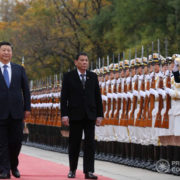Early this November, the Presidential Communications Office has laid out President Rodrigo Duterte’s administration’s infrastructure programs. These projects mostly aim to provide Filipinos more jobs, to reduce merchandise prices by ease of transport, and also, to give solution to the Philippines’ problems of heavy traffic, particularly in Metro Manila.
The Duterte administration has allocated about 5.4% of the 2017 government budget in infrastructures. Although it’s lower than the government’s initial statement of 7%, it’s still currently the largest infrastructure budget allocations compared to the previous administrations.
These projects, under the coordination of The National Economic and Development Authority (NEDA), the Department of Public Works and Highways (DPWH), the Department of Transportation (DOTr), and Bases Conversion and Development Authority (BCDA), is planned to have its constructions finished in about 3-5 years.
With the slogan, ‘Build Build Build,’ the Duterte administration plans to build more bridges and roads; build more railways, urban mass transports, airports and seaports; and build new and better cities.
BUILD
I. More Bridges and Roads
01 Santa-Monica-Lawton-BGC link Bridge
This bridge will directly link Ortigas and Bonifacio Global City (BGC) in Taguig that would free EDSA of about 100,000 vehicles, helping in the decrease of traffic congestion.
02 UP-Miriam-Ateneo Viaduct
It will connect Katipunan Avenue to CP Garcia avenue and will shrink the expected travel time between the two places for about 80%.
03 Iloilo-Guimaras-Negros-Cebu-Link-Bridge
This bridge will connect the islands of Panay in Iloilo, Guimaras, Negros, and Cebu–giving private and public transport vehicles easier and faster traveling route.
04 Davao City Bypass Construction Project
It will shorten the motorists’ travel time from Digos, Davao del Sur, to Panabo, Davao del Norte, and vice versa from present two hours to in just 45 minutes.
05 NLEX-SLEX Connect Road
This will connect the NLEX in Balintawak and SLEX in Alabang, with travel time of just about 30 minutes. Motorists no longer had to pass the usually jammed EDSA and C5, lessening the traffic congestion.
II. More Railways, Urban Mass Transports, Airports and Seaports
01 Manila-Clark Railway
This railway will let passengers arrive in Clark International Airport from Metro Manila in about one hour.
02 Metro-Manila Bus Rapid Train System
This infrastructure will help on the scheduling of buses to achieve on-time trips along EDSA and other big roads within Metro Manila.
03 Mindanao Railway
This assures the passengers, and well as merchandises, including perishable products, of cheaper expense but with just about two hours of travel time between the provinces of Davao, Surigao, and Cagayan de Oro.
04 Regional Airport Development
This project aims to build new regional airports with up-to-date facilities, as well as the renovation of other Philippine airports.
05 Roro Ports Development
This project aims to build infrastructures that will provide more accessible and cheaper travel expenses and transport of goods through sea ports.
III. New and Better Cities
01 Clark International Airport and New Building
This will be the Philippines’ first world-class airport which is also planned to ease the traffic and congestion at the Manila Ninoy Aquino International Airport (NAIA).
02 Clark Green City
This eco-friendly city is among the administration’s long term solution to Metro Manila’s heavy traffic.
03 BGC to NAIA Bus Rapid Transit (BRT) System
It will allow to the commuters to travel between BGC and NAIA in just 15 minutes.
04 Subic-Clark Cargo Railway Project
It will connect Subic port and Clark Airport, aspiring to lessen the population of trucks in Metro Manila and, at the same time, would also result in the lowering of commodity prices.






